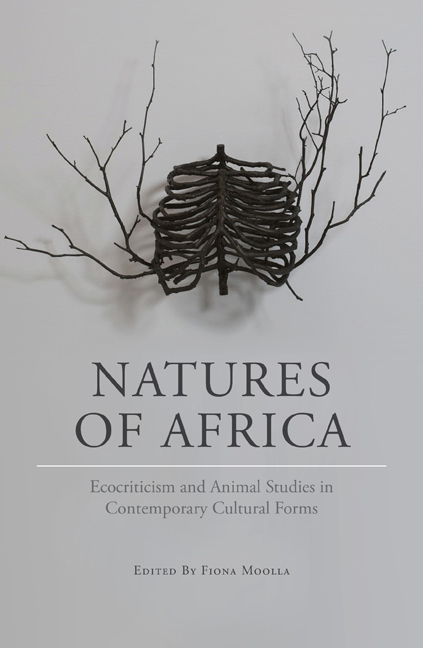Book contents
- Frontmatter
- Table of Contents
- Foreword
- Introduction
- 1 ‘Here is Some Baobab Leaf!’: Sunjata, Foodways and Biopiracy
- 2 Shona as a Land-Based Nature-Culture: A Study of the (Re)Construction of Shona Land Mythology in Popular Songs
- 3 The Environment as Significant Other: The Green Nature of Shona Indigenous Religion
- 4 Animal Oral Praise Poetry and the Samburu Desire to Survive
- 5 The Paradoxes of Voluntourism: Strategic Visual Tropes of the Natural on South African Voluntourism Websites
- 6 Towards an Ecocriticism in Africa: Literary Aesthetics in African Environmental Literature
- 7 Critical Intersections: Ecocriticism, Globalised Cities and African Narrative, with a Focus on K. Sello Duiker's Thirteen Cents
- 8 Navigating Gariep Country: Writing Nature-Culture in Borderline by William Dicey
- 9 Negotiating Identity in a Vanishing Geography: Home, Environment and Displacement in Helon Habila's Oil on Water
- 10 Human Masks? Animal Narrators in Patrice Nganang's Dog Days: An Animal Chronicle and Alain Mabanckou's Memoirs of a Porcupine
- 11 Nature, Animism and Humanity in Anglophone Nigerian Poetry
- 12 Animals, Nostalgia and Zimbabwe's Rural Landscape in the Poetry of Chenjerai Hove and Musaemura Zimunya
- About the authors
- Acknowledgements
- Notes
- Index
8 - Navigating Gariep Country: Writing Nature-Culture in Borderline by William Dicey
Published online by Cambridge University Press: 10 May 2018
- Frontmatter
- Table of Contents
- Foreword
- Introduction
- 1 ‘Here is Some Baobab Leaf!’: Sunjata, Foodways and Biopiracy
- 2 Shona as a Land-Based Nature-Culture: A Study of the (Re)Construction of Shona Land Mythology in Popular Songs
- 3 The Environment as Significant Other: The Green Nature of Shona Indigenous Religion
- 4 Animal Oral Praise Poetry and the Samburu Desire to Survive
- 5 The Paradoxes of Voluntourism: Strategic Visual Tropes of the Natural on South African Voluntourism Websites
- 6 Towards an Ecocriticism in Africa: Literary Aesthetics in African Environmental Literature
- 7 Critical Intersections: Ecocriticism, Globalised Cities and African Narrative, with a Focus on K. Sello Duiker's Thirteen Cents
- 8 Navigating Gariep Country: Writing Nature-Culture in Borderline by William Dicey
- 9 Negotiating Identity in a Vanishing Geography: Home, Environment and Displacement in Helon Habila's Oil on Water
- 10 Human Masks? Animal Narrators in Patrice Nganang's Dog Days: An Animal Chronicle and Alain Mabanckou's Memoirs of a Porcupine
- 11 Nature, Animism and Humanity in Anglophone Nigerian Poetry
- 12 Animals, Nostalgia and Zimbabwe's Rural Landscape in the Poetry of Chenjerai Hove and Musaemura Zimunya
- About the authors
- Acknowledgements
- Notes
- Index
Summary
‘The plot would be written by the current of the river itself.’
—Jonathan Raban, Coasting, cited in George (1992: 258)‘… rivers and those who step into them are always in flux.’
—Blanton (2002: xii)As a child growing up near the confluence of the Kraai and Orange rivers, I used to wonder what tales the brown water brought and gathered on its way to the sea. I remember the many dry seasons and occasional floods, when debris and the bodies of humans and animals would rush past. But the river not only evoked notions of far-off places or the coming and going of seasons, it also served as a constant reminder that we lived in a border zone: the North Eastern Cape of old on the one side, the Orange Free State on the other.
Apart from the railway bridge, the dusty little town's only link north remains a two-lane crossing with an old bridgehead and a toll house near the southern entrance – architectural reminders of the town's 19th-century past. Geographically, the river divides the land and brings water to a place where just a few kilometres inland sheep would stand in clusters in the shimmering heat, their heads hung low in one another's shade. Along the town's embankment, more structures recall histories of hardship and separation. East of the bridge is Aborsig, previously a white suburb for the more affluent. Further on stands a blockhouse, now a garden of remembrance, and on the bank of the Kraai River there used to be two cemeteries that held the graves of those who died in the concentration camp that was here during the South African War. Left of the bridge, another burial ground embraces the remains of my parents and sisters. Past the railway line, downstream, reaching out into the dull, dry distance, enduring edifices of the black and coloured townships of the old South Africa remain, with a multi-columned granary etched against the horizon. This district, this seemingly inconsequential, bleak border town, which, by virtue of its geographical features and isolation, is not always worthy of the spectacular, is one of many places along the flow of the Orange River that signify the territory's history of suffering and marginalisation.
- Type
- Chapter
- Information
- Natures of AfricaEcocriticism and Animal Studies in Contemporary Cultural Forms, pp. 187 - 211Publisher: Wits University PressPrint publication year: 2016



